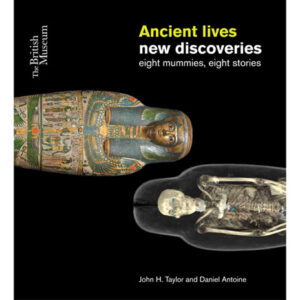 Ancient Lives, New Discoveries, John H. Taylor, Daniel Antoine
Ancient Lives, New Discoveries, John H. Taylor, Daniel Antoine
Ancient Lives, New Discoveries is a fascinating volume which peers beneath the wrappings of eight mummies in the British Museum’s collection, using state of the art CT scanning and reconstruction to do so completely non-destructively. The mummies are from different areas of Egypt, and different eras as well, from mummies preserved naturally through to mummies prepared using every trick of the embalmers’ trade. There are amazing images in this book, with various different views of each mummy, and additional notes explaining significant features (like poles used to stabilise detached heads, an odd metal(?) ring somewhere in the oldest mummy’s abdomen, etc. There’s also some background information of a fairly basic sort, if you already know a fair bit about Egypt — if you don’t, this volume gets you up to speed enough to understand the mummies, in relatively few pages.
One quibble I had was the constant insistence that male bodies in sarcophagi with female names were definitely put there by accident (either in antiquity or now). I’ll admit I don’t know anything about gender in Ancient Egypt, but gender has always been fluid and expressed in different ways in different societies. Probably some of the bodies are in the wrong sarcophagi, owing to the way their tombs were pillaged and the way collections were swapped about with little attention paid to provenance. But… just maybe some of the ambiguities might be best resolved by thinking about whether we’re looking at gender the same way. Clearly the wrapping and presentation of mummies reflected social roles as much as anything else, as demonstrated by the young girl identified as a temple singer, mummified and presented as a desirable young woman — the intent does not seem to have been to reflect a person accurately, at any rate. Who says they weren’t wrapped and presented in a way meant to represent who they were in life, rather than the bare details biology gives us?
I know I’m not an expert in that field, but I can’t help but think that some acknowledgement of that as a possibility would have fit in well. Instead, it felt as if everything was explained away as a mistake on someone else’s part, rather than a potential misunderstanding on the part of those investigating the mummies now.
Still a fascinating book, though; perfect for someone fascinated by mummies.

Ancient Egypt always fascinated me-all the different Gods and Goddesses, the mythology, exploring the tombs etc. I just don’t get the time to read about the subject. I love visiting museums and actually seeing sarcophagi-it’s pretty exciting looking at them!
Same! This book really added something to that experience, because I’ve seen all the mummies in the British Library and now I’ve seen beneath their wrappings?! Technology, wow!